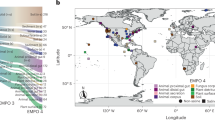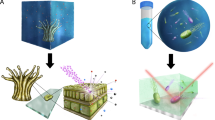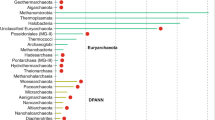Abstract
At the heart of microbial ecology lies a true scientific dichotomy. On the one hand, we know microbes are responsible for processes on which all other life on Earth is dependent; their removal would mean the cessation of all known life. However, in opposition, the majority of extant microbial species in natural environments have never been cultured or studied in a laboratory as living organisms. Owing to these factors, the question of “who does what?” has been a major barrier to understanding how microbially mediated ecosystem level events occur. Recently, the use of stable isotopes (13C) to trace carbon from specific substrates into microbes that assimilate carbon from that substrate has significantly advanced our understanding of the relationship between environmental processes and microbial phylogeny.
This is a preview of subscription content, access via your institution
Access options
Subscribe to this journal
Receive 12 print issues and online access
$259.00 per year
only $21.58 per issue
Buy this article
- Purchase on Springer Link
- Instant access to full article PDF
Prices may be subject to local taxes which are calculated during checkout


Similar content being viewed by others
References
Boschker, H.T.S. et al. Direct linking of microbial populations to specific biogeochemical processes by C-13-labelling of biomarkers. Nature 392, 801–805 (1998).
Radajewski, S., Ineson, P., Parekh, N.R. & Murrell, J.C. Stable-isotope probing as a tool in microbial ecology. Nature 403, 646–649 (2000).
Manefield, M., Whiteley, A.S., Griffiths, R.I. & Bailey, M.J. RNA stable isotope probing, a novel means of linking microbial community function to phylogeny. Appl. Environ. Microbiol. 68, 5367–5373 (2002).
Manefield, M., Griffiths, R.I., Leigh, M.B., Fisher, R. & Whiteley, A.S. Functional and compositional comparison of two activated sludge communities remediating coking effluent. Environ. Microbiol. 7, 715–22 (2005).
Kasai, Y., Takahata, Y., Manefield, M. & Watanabe, K. RNA-based stable isotope probing and isolation of anaerobic benzene-degrading bacteria from gasoline-contaminated groundwater. Appl. Environ. Microbiol. 72, 3586–3592 (2006).
Lueders, T., Pommerenke, B. & Friedrich, M.W. Stable-isotope probing of microorganisms thriving at thermodynamic limits: syntrophic propionate oxidation in flooded soil. Appl. Environ. Microbiol. 70, 5778–5786 (2004a).
Lueders, T., Wagner, B., Claus, P. & Friedrich, M.W. Stable isotope probing of rRNA and DNA reveals a dynamic methylotroph community and trophic interactions with fungi and protozoa in oxic rice field soil. Environ. Microbiol. 6, 60–72 (2004b).
Mahmood, S., Paton, G.I. & Prosser, J.I. Cultivation-independent in situ molecular analysis of bacteria involved in degradation of pentachlorophenol in soil. Environ. Microbiol. 7, 1349–1360 (2005).
Lueders, T., Kindler, R., Miltner, A., Friedrich, M.W. & Kaestner, M. Identification of bacterial micropredators distinctively active in a soil microbial food web. Appl. Environ. Microbiol. 72, 5342–5348 (2006).
Griffiths, R.I. et al. 13CO2 pulse labelling of plants in tandem with stable isotope probing: methodological considerations for examining microbial function in the rhizosphere. J. Microbiol. Methods 58, 119–129 (2004).
Rangel-Castro, J.I. et al. Stable isotope probing analysis of the influence of liming on root exudate utilization by soil microorganisms. Environ. Microbiol. 7, 828–838 (2005).
Lu, Y. & Conrad, R. In situ stable isotope probing of methanogenic Archaea in the rice rhizosphere. Science 309, 1088–1090 (2005).
Lu, Y., Rosencrantz, D., Liesack, W. & Conrad, R. Structure and activity of bacterial community inhabiting rice roots and the rhizosphere. Environ. Microbiol. 8, 1351–1360 (2006).
Whiteley, A.S., Manefield, M. & Lueders, T. Unlocking the “microbial black box” using RNA-based stable isotope probing technologies. Curr. Opin. Biotechnol. 17, 67–71 (2006).
Griffiths, R., Whiteley, A.S., O'Donnell, A.G. & Bailey, M.J. Rapid method for coextraction of DNA and RNA from natural environments for analysis of ribosomal DNA and rRNA-based microbial community. Appl. Environ. Microbiol. 66, 5488–5491 (2000).
Ostle, N., Whiteley, A.S., Bailey, M.J., Sleep, D., Ineson, P. & Manefield, M.J. Active microbial turnover in a grassland soil estimated using a 13CO2 “spike”. Soil Biol. Biochem. 35, 877–885 (2003).
Lueders, T., Manefield, M. & Friedrich, M.W. Enhanced sensitivity of DNA- and rRNA-based stable isotope probing by fractionation and quantitative analysis of isopycnic centrifugation gradients. Environ. Microbiol. 6, 73–78 (2004).
Stubner, S. Enumeration of 16S rDNA of Desulfotomaculum lineage 1 in rice field soil by real-time PCR with SybrGreen detection. J. Microbiol. Methods 50, 155–164 (2002).
Lane, D.J. 16S/23S rRNA sequencing. in Nucleic Acid Techniques in Bacterial Systematics (eds. Stackebrandt, E. & Goodfellow, M.) 205–248 (Wiley, Chichester, England, 1991).
Acknowledgements
A.S.W. acknowledges Dr Ian Douglas of Beckman Coulter for his continuous expert input into the centrifugation equipment technologies required during RNA-SIP development. We acknowledge The UK's Natural Environment Research Council for financial support to develop RNA-SIP. T.L. acknowledges the Helmholtz Society for funding during the preparation of this manuscript. We finally thank two anonymous referees whose comments provided additional clarifications to the protocol.
Author information
Authors and Affiliations
Corresponding author
Ethics declarations
Competing interests
The authors declare no competing financial interests.
Rights and permissions
About this article
Cite this article
Whiteley, A., Thomson, B., Lueders, T. et al. RNA stable-isotope probing. Nat Protoc 2, 838–844 (2007). https://doi.org/10.1038/nprot.2007.115
Published:
Issue Date:
DOI: https://doi.org/10.1038/nprot.2007.115
This article is cited by
-
Competition-based screening helps to secure the evolutionary stability of a defensive microbiome
BMC Biology (2021)
-
Methanotrophic Community Detected by DNA-SIP at Bertioga’s Mangrove Area, Southeast Brazil
Microbial Ecology (2021)
-
Sulfide-driven denitrification: detecting active microorganisms in fed-batch enrichment cultures by DNA stable isotope probing
Molecular Biology Reports (2019)
-
Untersuchung prozessrelevanter mikrobieller Populationen mittels RNA-SIP
BIOspektrum (2018)
Comments
By submitting a comment you agree to abide by our Terms and Community Guidelines. If you find something abusive or that does not comply with our terms or guidelines please flag it as inappropriate.



